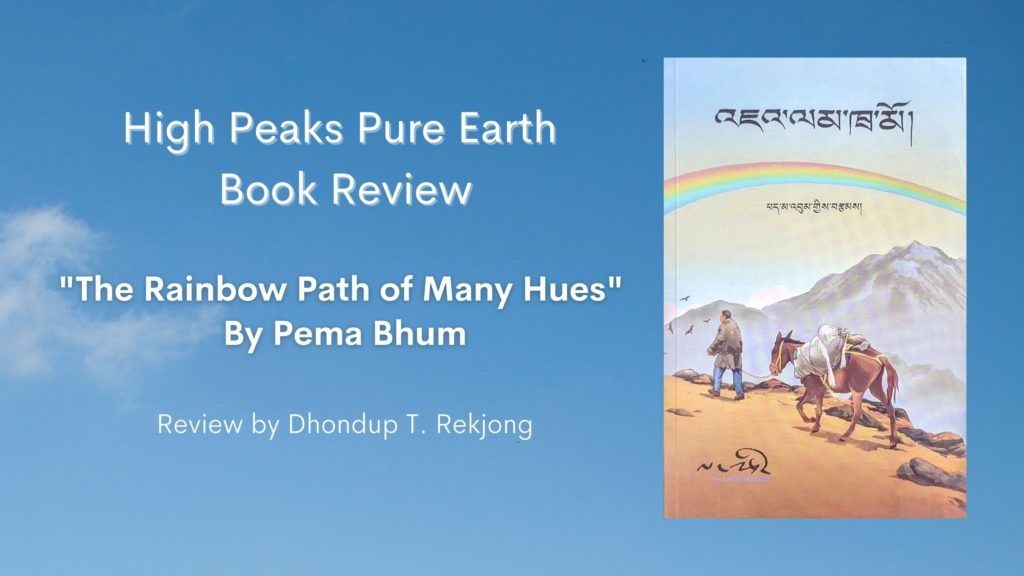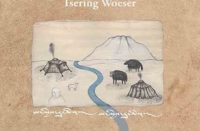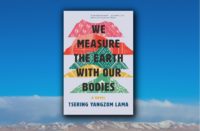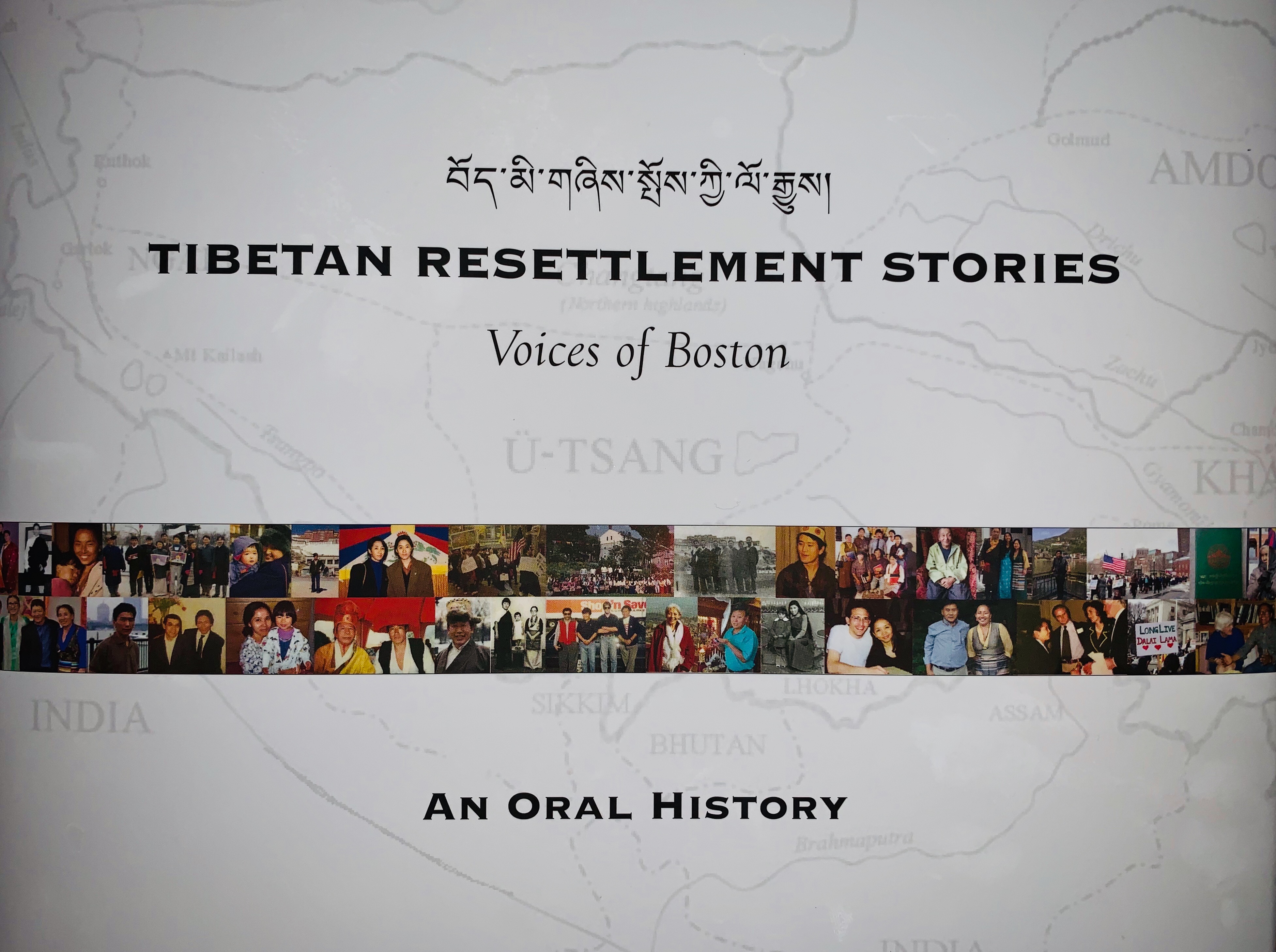High Peaks Pure Earth presents a review of Pema Bhum’s Tibetan language novel འཇའ་ལམ་ཁྲ་མོ། “The Rainbow Path of Many Hues”, written by Dhondup T. Rekjong*. “The Rainbow Path of Many Hues” was published in May 2023 by the Latse Project and printed and distributed by Tibet Times. For purchase enquiries please contact Tibet Times: https://tibettimes.net/about-us/#Eng
“The Rainbow Path of Many Hues” will also feature on our Summer 2023 Tibet Reading List which will be online soon.

Book Review: “The Rainbow Path of Many Hues” By Pema Bhum
Review By Dhondup T. Rekjong
Pema Bhum is one of the most important contemporary writers in Tibetan. His previous works have had a tremendous impact in Tibet and beyond. His 1999 essay “The Heartbeat of a New Generation” showed how writers responded to religious conservatism and Chinese communism in the early 1980s, escaping both through poetry. Published in Dharamsala, India, the book found its way to the underground market in Tibet, attesting to its popularity. His ground-breaking memoirs, Six Stars with a Crooked Neck (translated into Spanish, French, and Polish) and Remembering Dorje Tsering, shed light on the preservation of the Tibetan language during the Cultural Revolution. One has undergone more than four reprints, and some universities in North America and Europe have incorporated his work into their Tibetan Studies curriculums.
It took Pema Bhum nearly eight years to complete The Rainbow Path of Many Hues, his debut novel, which picks up where his essays left off, using fiction to relate the transformations of Tibet under China’s control. The narrative revolves around Longrik, a monk from a small village in Amdo who escapes to India in the 1980s; the author skillfully weaves Longrik’s experiences with significant political, economic, and cultural transformations.
The story begins as Longrik joins a local monastery. His stay is short-lived, due to the unexpected news of his former girlfriend’s pregnancy. On impulse, Longrik and his friends Paktuk and Rinchen Dolma, leave for Lhasa. There, they are caught up in a demonstration, leading to their separation. Fortunately, Longrik meets an old acquaintance, who becomes his companion on the perilous journey to the border. When their truck is stopped by the police, Longrik manages to evade arrest and loses himself amidst the countryside of upper Tibet. He stumbles upon the home of a blacksmith, who asks him to perform a sky burial. Later, he is caught by border police and handed over to a Chinese businessman named Mr. Tang. Longrik crosses into Nepal and proceeds to Varanasi in Uttar Pradesh, India, where His Holiness the Dalai Lama is delivering a teaching, before arriving in Dharamsala. His journey is a symbolic roadmap for Tibetans who chose exile in India, representing the unpredictable paths they had to navigate.
From the first page to the last, the novel was impossible to put down. The author’s construction of Longrik’s world left me in awe. It became increasingly difficult to predict what would happen to the protagonist, as his life became entangled in a web of personal and political events. Moreover, the incidents that shape Longrik’s life are profoundly influenced by the sweeping social, economic, and political transformations of the early 1980s.
The reader is not alone in being unable to foresee Longrik’s future; his plans are profoundly influenced by his own actions as well as the political circumstances that exert control over his precarious existence. Before leaving the monastery, Longrik does not anticipate any of the incidents that occur on his journey. His loss of control over his own agency keeps the reader filled with suspense. In essence, Longrik’s precariousness transforms the novel into a page-turner.
Following Longrik, readers gain insight into the impact of China’s political rule, which failed to win the hearts and minds of the Tibetan people. The writer captures the subtleties of existence in diverse situations across Tibet. In Longrik’s hometown, even those with the opportunity to pursue monastic studies and indulge in Chinese action movies express a deep longing to go to India. These same monks seek to understand their own history through works like Tibet: A Political History by Wangchuk Deden Shakabpa (1908-89), rather than Chinese publications. Upon seeing the book for the first time, Longrik’s friend Paktu asks, “Is this the book telling how the Tibetan army attacked the Chinese capital and even forced the Chinese King to leave his residence?”
Several actual uprisings occurred in Lhasa in the late 1980s. In the novel, Longrik and his friends are lined up with other devotees outside the Jokhang temple when the Barkhor area becomes swamped by a massive crowd shouting “Tibet Belongs to Tibetans!” and “Long Live His Holiness the Dalai Lama!” In the fervor, someone hands them a Tibetan flag and a picture of the Dalai Lama. Spontaneously, they become protesters, experiencing a pivotal moment in their life.
The protest in Lhasa had far-reaching consequences, causing increased political gatherings and heightened restrictions on mobility beyond the city. The lingering effects of the Cultural Revolution are still evident. The blacksmith reveres Chairman Mao, participates in political meetings, and even spreads government propaganda. He nearly reports Longrik to the authorities. “Son, if you were with those who protested against Chairman Mao in Lhasa, I can’t tolerate it; I should report you,” the blacksmith warns.
Throughout, Buddhism emerges as an invisible force that sustains and preserves Tibetan culture. Wherever Longrik travels, he observes Buddhism’s prevailing influence, even among the Chinese. When he is apprehended by the police in Dram, they entrust him to Mr. Tang before transferring him to the police station. During his stay at Mr. Tang’s, Longrik discovers a precious Buddhist text, the Sutra of the Sacred Golden Light. “My business is not going well; could you please recite this precious text to diminish my obstacles?” Mr. Tang requests.
Similarly, Pema Bhum skillfully depicts how Tibetans hold religious blessings in high regard. When Longrik loses his friend’s copy of Perfection of Wisdom in Eight Thousand Lines at Xining bus station, his friend becomes frustrated: “You could buy a new text, but you can’t buy its blessing.” While at the blacksmith’s house, his host advises him against taking another copy of the same text outside: “To stay its blessing within our house, we never took it outside because wind and sunlight might take its blessing away,” he explains. When Longrik sees the Sutra of the Sacred Golden Light at Mr. Tang’s, he is nearly moved to tears. The blessings bestowed by religious texts become sources of courage, protection, and guidance as he confronts unforeseen challenges.
The novel incorporates multiple contradictions within each theme, allowing readers to observe characters without explicit explanation. The blacksmith is politically indoctrinated yet deeply values his religious convictions. When his wife passes away, he requests Longrik to recite the text of Perfection of Wisdom in Eight Thousand Lines, saying “How lucky Tsamchok is; she left into the sound of the prayers of the Sutra.” An equally complicated scenario involves Mr. Tang, who initially appears kind and generous, but engages in the trafficking of teenage girls from Nepal to affluent Chinese who frequent the border town. Longrik overhears a conversation between a Nepalese businessman and Mr. Tang’s assistant in Nepal, wherein they discuss the plight of the girls. “If you don’t take over the girls, I have to send them back to their villages. Some of them even cry missing their mothers,” the man complains.
When Longrik reaches his destination, the writer presents the reception centre at Dharamsala, where individuals from all corners of Tibet meet. Each has their own motives for seeking exile: some are driven by political circumstances, others seek educational opportunities, and some arrive without clear ambitions. Among them, Longrik encounters a local chieftain who often expresses frustration about the lack of respect shown by other Tibetans. “If I were not in exile…” he sighs, conveying his longing for his traditional status.
Through Longrik’s interactions with the new government’s officials, the writer reflects on the elite social and linguistic expressions prevalent within the Tibetan government in exile. When Longrik meets with the minister of the department of information and foreign affairs, he is unaware of the expectations of responding with a “Yes” and bowing his head when the minister speaks. Only through a discreet pinch from his assistant does Longrik learn the protocols. Having a private audience with His Holiness the Dalai Lama and being recognized as the next reincarnate lama of his local monastery back in Tibet leaves him in mixed state of happiness and sadness.
Overall, this novel offers a compelling window into Tibetan society during the early 1980s. I strongly recommend it to all Tibetan readers; a work of this caliber emerges once in a few decades. If you do not know Tibetan, I urge you to anticipate its translation into English.
*Dhondup T. Rekjong is a Tibetan scholar and doctoral candidate in the Department of Religious Studies at Northwestern University. His writings have appeared in The Wall Street Journal, Chicago Tribune, The Journal of Asian Studies, The Journal of Cultural Anthropology, Lion’s Roar, The Treasury of Lives and others.




Follow Us!